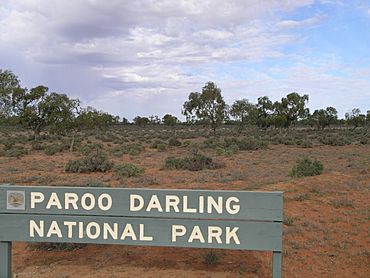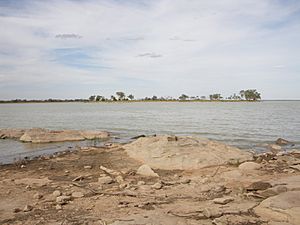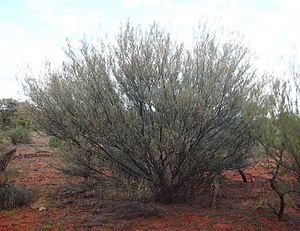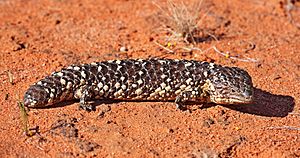Paroo-Darling National Park facts for kids
Quick facts for kids Paroo-Darling National ParkNew South Wales |
|
|---|---|
|
IUCN Category II (National Park)
|
|

Sign at entrance
|
|
| Nearest town or city | White Cliffs |
| Established | March 2000 |
| Area | 1,780.53 km2 (687.5 sq mi) |
| Managing authorities | NSW National Parks & Wildlife Service |
| Website | Paroo-Darling National Park |
| Footnotes | |
| Official name: Paroo River Wetlands | |
| Designated: | 13 September 2007 |
| Reference #: | 1716 |
| See also | Protected areas of New South Wales |
The Paroo-Darling National Park is a special protected area in the Far West of New South Wales, Australia. This huge park, covering about 178,053 hectares (that's over 440,000 acres!), stretches across two different parts of the Australian outback. It includes dry river areas of the Paroo River and where the Paroo River meets the Darling River. It's a place where nature is protected and ancient history is preserved.
Contents
A Journey Through Time: Park History
This park is very important for Aboriginal heritage. You can find signs of life from thousands of years ago. These include old campfires, stone tools, and trees where bark was taken. Before Europeans arrived, the Paakantyi people lived here.
The first European explorer to visit was Charles Sturt in 1844. Later, in the 1860s, people came looking for land for sheep and cattle. This area became part of a huge property called Momba Station. Over time, Momba Station was divided into smaller parts.
The Paroo-Darling National Park was created between 2000 and 2003. The Government of New South Wales bought seven properties to form the park. The first part, Peery, became Peery National Park in 2000. Later, Mandalay and Arrowbar were added. In 2002, these areas became part of the larger Paroo-Darling National Park. These first parts are near White Cliffs.
Exploring the Paroo Overflow Section
The Paroo River Overflow section of the park is in the far west of New South Wales. It's about 30 kilometres east of White Cliffs. This part of the park covers about 96,000 hectares. It includes the former properties of Peery, Mandalay, and Arrowbar.
This area is part of the Mulga Lands Bioregion. It has amazing plants, animals, and landscapes. The wetlands here, along with Nocoleche Nature Reserve, are a special Ramsar site. This means they are important wetlands for the world. The park also has rare artesian mound springs. These are considered the rarest landforms in Australia.
The Park's Natural Environment
The park's landscape features grey, cracking clay soils and red sand hills. These are found along the Darling River floodplains. Peery and Poloko Lakes are part of the Paroo overflow system. They are very important for wildlife.
Lakes and Waterways
When full, Peery Lake covers about 5,026 hectares. It is the biggest of the Paroo Overflow lakes. This lake is a haven for water birds. When it's full, it can hold water for several years. When dry, Peery Lake is the only place in New South Wales where you can see Great Artesian Basin mound springs in a lakebed.
Most of the park is within the Paroo Floodplain and Currawinya Important Bird Area. This area is recognized by BirdLife International. It's important because it supports many waterbirds when conditions are right.
Plants of the Park
The park is in the Mulga Lands Bioregion. This area stretches from northwestern NSW into southwestern Queensland. It has many different landforms, each with unique plants and ecosystems. The main plant type here is mulga (Acacia aneura). There are also other woody shrubs.
The climate is dry, with low and unpredictable rainfall. This leads to long droughts and sometimes big floods. Evaporation is much higher than rainfall, so water is scarce. Summers are hot, and winters are mild. This region has suffered from overgrazing in the past. This has reduced the variety of plants and animals.
Landforms and Lakes
The park protects different landforms. These include the Peery Hills with rugged gorges and low cliffs. There are also sand plains and dune fields. The park has two large lakes, Lake Peery and Lake Poloko. These lakes are part of the Paroo Overflow lake system.
They usually fill up about once every five years. They stay full for one to three years. These are freshwater lakes, but they become salty as they dry. These wetlands are important places for biodiversity in the region. They depend on the changing flows of the Paroo River. This is the last unregulated river system in the Murray-Darling Basin. The natural flooding and drying of the river helps create many different habitats. This supports a wide variety of life.
Animals of the Park
The park is home to many animals typical of Australia's dry regions. You can see large macropods like the red kangaroo (Macropus rufus), eastern grey kangaroo (M. gigantius), western grey kangaroo (M. fuliginosus), and euro (M. robustus).
Several vulnerable mammal species also live here. These include the yellow-bellied sheath-tailed bat (Saccolaimus flaviventris), little pied bat (Chalinilobus picatus), inland forest bat (Vespadelus baverstocki), and stripe-faced dunnart (Sminthopsis crassicaudata).
Surveys have found 44 types of reptiles and 8 types of amphibians. These include the wedgesnout ctenotus (Ctenotus brooksi) and crowned gecko (Diplodactylus stenodactylus). Other reptiles seen are the lace monitor (Varanus varius), shingleback (Tiliqua rugosa), carpet python (Morelia spilota metcalfei), and mulga snake (Pseudechis australis).
The park's wetlands are vital during droughts. When the lakes are full after floods, they support many aquatic species and waterbirds. In 1993, over 35,900 waterbirds of 42 species were counted on Peery Lake. The number of birds changes with water levels. Peery and Poloko Lake also provide important homes for migratory shorebirds. Five waterbird species listed as vulnerable in NSW have been seen here. These include the freckled duck (Stictonetta naevosa), blue-billed duck (Oxyura australis), brolga (Grus rubicunda), painted snipe (Rostratula benghalensis), and black-tailed godwit (Limosa limosa).
Park Flora: Diverse Plant Life
The park has a wide variety of plants, with 424 different species recorded. The most common plant communities include mulga shrubland and various types of Eremophila, Dodonaea, Acacia, and black bluebush.
The park protects two endangered plant communities. These are artesian mound springs and nelia (Acacia loderi) woodland. Artesian mound springs are also listed as threatened nationally. The park is home to one nationally endangered plant, salt pipewort (Eriocaulun carsonii). It also has four plant species listed as endangered in NSW. Salt pipewort is one of the rarest plants in NSW. The only population in NSW is found in the Lake Peery mound springs.
Understanding Artesian Mound Springs
Artesian mound springs form when water from the Great Artesian Basin comes to the surface. This happens through cracks in the rocks. As the water evaporates, it leaves behind salts and sediments. These build up to form the special mounds the springs are named after.
Mound springs provide a permanent water source in dry areas. They are a threatened community because they need a very specific habitat. Without this water, many species living there could not survive. This also means that species in these habitats often have small populations. Artesian mound springs are considered the rarest landform in Australia.
Several mound springs are found on the bed of Lake Peery. These form the largest active mound spring complex in NSW. They are the only known springs in NSW found on a lakebed. They are also the only ones protected within NSW's reserve system. The Lake Peery mound springs are culturally important to local Aboriginal people. They were a reliable source of fresh water and are part of local dreamtime stories.
Salt pipewort only grows in active artesian mound springs. In NSW, it has only been found in two places: Lake Peery and Wee Watah Springs. The population at Wee Watah Springs has died out. This means all remaining salt pipewort in NSW is now found within the park.
One big threat to mound springs is taking water from the Great Artesian Basin for farming. This lowers the water pressure, reducing spring flows. Most mound springs in western New South Wales have disappeared because of this. Other threats include trampling and grazing by wild animals like goats and rabbits. Wild pigs can also cause damage by digging for roots.
Challenges and Environmental Threats
Introduced species, both plants and animals, threaten the park's biodiversity. A total of 55 introduced plant species have been found. Priority weeds include Bathurst burr, Noogoora burr, and African boxthorn. These plants can harm native species by competing for resources.
Introduced foxes and wild cats are a threat to many small animals in the park. They hunt these native species. These animals have caused many native species to disappear from the region. They remain a major threat to animals in Australia's dry areas. Overgrazing by farm animals and wild animals like rabbits and goats has changed plant communities. The park was once used for grazing, which caused erosion and reduced new plant growth. Rabbits, wild goats, and farm animals from nearby properties still threaten the park's ecosystems. Introduced fish, like European carp, also threaten the park's water ecosystems. They compete with and eat native fish.
A major threat to the park's wetlands is possible future changes to the Paroo River's flow. The wetland ecosystems are adapted to the river's naturally changing flow. Changes to this flow could harm the wetlands. This could lead to isolated animal populations or changes in species. It could also remove breeding signals for waterbirds and fish. Water extraction or building levees could affect the natural flow.
Climate change also threatens ecosystems across Australia. Predictions for western NSW include higher temperatures and less average rainfall. However, there might be more intense rain events. This could lead to more frequent and intense fires. It could also mean more droughts and less river water. Climate change threatens the park's biodiversity by changing population sizes and distributions. It can also make other threats, like wild animals, worse. Changes to the Paroo River's flow due to climate change could negatively impact the wetlands.
How the Park is Managed
Conservation areas like this park are very important for protecting biodiversity in dry Australia. This park helps protect the Mulga Lands Bioregion. The park is managed by the NSW National Parks and Wildlife Service. They work with the Paroo-Darling National Park Elders Council. Park management focuses on controlling introduced species and managing fires.
Controlling introduced species targets those that are harmful to the environment. Rabbits are controlled by finding and destroying their burrows. Wild goats are rounded up by contractors. Wild pigs are controlled by aerial shooting, and foxes by baiting programs. Whenever possible, control efforts are coordinated with nearby landowners. This makes them more effective.
Fire has always played a role in shaping Australia's ecosystems. In dry regions, fire affects plant structure and species. Changes to fire patterns, like more intense or frequent fires, can harm biodiversity. Fires in the park are managed to protect biodiversity, property, and Aboriginal sites. Controlled burns are used to manage fuel loads. They also mimic traditional Aboriginal burning patterns.
Visiting the Park: Access Information
You can reach the national park by dry weather roads. These roads lead from the villages of White Cliffs, about 20 km away, or Wilcannia. The visitor centre at White Cliffs can give you the latest information about the Paroo-Darling National Park.
Camping is allowed at the Coach and Horses campground. This is at the old Wilga Station, about 50 km east of Wilcannia.







